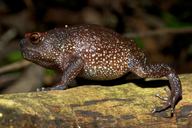|
Callulina laphami Loader, Gower, Ngalason & Menegon, 2010
| family: Brevicipitidae genus: Callulina |
| Species Description: Loader SP, Gower DJ, Ngalason W, Menegon M 2010 Three new species of Callulina (Amphibia: Anura: Brevicipitidae) highlight local endemism and conservation plight of Africa's Eastern Arc forests. Zool J Linn Soc 160: 496-514. | |
 © 2010 Michele Menegon (1 of 1) |
|
|
|
Description Callulina laphami can be distinguished from its very similar congener C. shengena by the presence of prominent glands on the arms and legs (absent in C. shengena). C. laphami is also similar to C. dawida but can be distinguished by the absence of tympana (present but sometimes obscured in C. dawida). Callulina laphami can be distinguished from its congeners C. kisiwamsitu, C. kreffti and C. stanleyi by the lack of tympana (present in C. kisiwamsitu, C. kreffti and C. stanleyi), having smoother, less granular skin, finger and toe tips that are truncate, and a brightly colored interocular band (absent in C. kisiwamsitu, C. kreffti, and C. stanleyi). Description: Body robust and stout, with males attaining snout-urostyle lengths of 22.8-29.0 mm and females reaching snout-urostyle lengths of 33.5-45.4 mm. Snout visible in ventral view. Tympanum is absent. Forelimbs have a slightly raised glandular area on the dorsal/dorsolateral surface, from the wrist to the elbow joint. Fingertips are truncate and rounded with circummarginal grooves. Relative finger lengths are III>IV=II>I. Inner metacarpal tubercle is large, raised, and rounded, but still smaller than the outer metacarpal tubercle, which runs along the margin of the hand. A middle palmar tubercle separates the two metacarpal tubercles and smaller palmar tubercles are also present. Fingers bear subarticular tubercles at the base of each digit and at the phalangeal joints on Fingers III-IV. Hindlimbs have a slightly raised glandular region running from the knee joint to the tibiotarsal joint, on the dorsal, lateral, and ventral surfaces; a glandular region also runs from the tibiotarsal joint to the base of the foot, on the dorsal, lateral, and ventral surfaces. Toe tips are dorsoventrally swollen but are not expanded laterally and do not have lamellae on the ventral surfaces; they bear circummarginal grooves. Relative toe lengths are IV>III=V>I=II. Toes bear subarticular tubercles at the base of each digit and at the phalangeal joints on Toes III-IV. Inner metatarsal tubercle is large, raised, and rounded, and abuts the smaller, raised and rounded outer metatarsal tubercle. Plantar tubercles are present at the base of the sole. The dorsal skin is very slightly granular but mostly smooth, bearing glandular, granular masses laterally and ventrally and at the posterior around the thighs and urostyle. Coloration in life: dark brown dorsum, shading to paler brown on the flanks and then to yellowish cream ventrally. Bright red (or occasionally green) interocular band that marks anterior and posterior edges of eyelid. Flanks are brown, but paler than the dorsum In juveniles the dorsum may be more of a reddish color. Distribution and Habitat Country distribution from AmphibiaWeb's database: Tanzania, United Republic of
Life History, Abundance, Activity, and Special Behaviors Trends and Threats Possible reasons for amphibian decline General habitat alteration and loss Comments Etymology: Named for Lewis H. Lapham in honor of his support for Tanzanian forest conservation, which is especially critical for endemic species with restricted ranges such as C. laphami. Species authority: Described by Loader et al. (2010). Loader et al. (2010) noted that species in the genus Callulina can be distinguished from all other brevicipitids by having truncate to expanded digit tips (vs. rounded tips in other brevicipitid species), and are often found climbing on vegetation when not sheltering, in contrast to the burrowing lifestyle favored by other brevicipitids. Loader et al. also provide a key to distinguish between all known species of Callulina.
References
Loader, S. P., Gower, D. J., Ngalason, W., and Menegon, M. (2010). ''Three new species of Callulina (Amphibia: Anura: Brevicipitidae) highlight local endemism and conservation plight of Africa's Eastern Arc forests.'' Zoological Journal of the Linnean Society, 160, 496-514. Originally submitted by: Kellie Whittaker (first posted 2010-10-31) Edited by: Kellie Whittaker (2010-10-31) Species Account Citation: AmphibiaWeb 2010 Callulina laphami <https://amphibiaweb.org/species/7581> University of California, Berkeley, CA, USA. Accessed Apr 16, 2025.
Feedback or comments about this page.
Citation: AmphibiaWeb. 2025. <https://amphibiaweb.org> University of California, Berkeley, CA, USA. Accessed 16 Apr 2025. AmphibiaWeb's policy on data use. |


 Map of Life
Map of Life